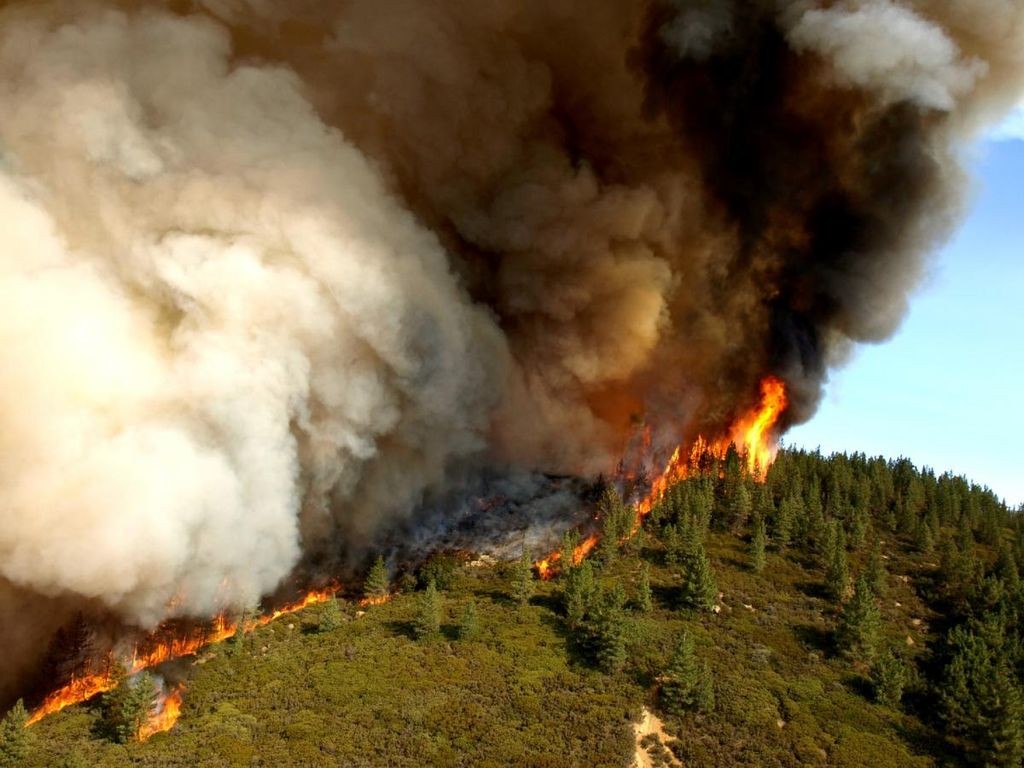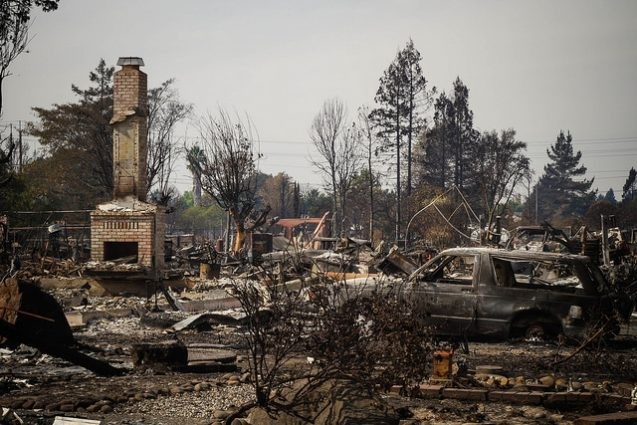With climate change likely to increase the frequency and intensity of wildfires, we will need to actively review the way that we are responding to, adapting to, and modeling them.

Leader: Richard Seager, Lamont-Doherty Earth Observatory
About the Readings
Human Exposure and Sensitivity to Globally Extreme Wildfire Events
Bowman et al., 2017, Nature Ecology & Evolution
This paper reports that economically or socially disastrous extreme wildfires are concentrated in suburban areas intermixed with flammable forest in the developed world. Regional land use can reduce the occurrence of fire disasters. Climate change is likely to increase the frequency of extreme wildfires. The paper notes the pivotal role of meteorological conditions in driving extreme wildfire events, signaling increased global vulnerability to these events with climate change.
Wildfire Risk as a Socioecological Pathology
Fischer et al., 2016, The Ecological Society of America
Wildfire risk is increasing on a global scale, causing huge economic loss; nevertheless, fire is an essential ecological process. The authors define this as a socioecological pathology: a set of interrelated social and ecological conditions and processes that deviate from what is healthy/desirable. The authors use a coupled natural and human systems (CNHS) perspective to understand the pathology of wildfire risk in fire-prone temperate forests and suggest strategies to mitigate it. Finding solutions requires paying more attention to the interplay between social and ecological conditions and processes that influence human decision-making (wildfire governance system).
Learning to Coexist with Wildfire
Moritz et al., 2014, Nature
Policy strategies to address wildfires often emphasize fuel reduction; the authors state that viewing fire in the context of socioecological systems (SESs), recognizing the link between human and natural environments, provides insights into achieving a more sustainable coexistence with wildfire. This paper summarizes research on fire-prone ecosystems and fire effects on human communities through the lens of SESs. The authors suggest that context-specific and place-based approaches will be needed, and that greater attention to land-use planning is warranted.
Discussion Summary
Fire with respect to humans and human settlement is a problem that is becoming more intense in many regions of the world, especially semi-arid regions like the Western U.S., Australia, and the Mediterranean. Climate change makes the potential for fire worse, for simple physical reasons. Climate models predict vapor pressure deficit to increase (defined as the difference in moisture between what the air has and what it could hold). Ecosystems and people do adjust to an overall drier mean climate. Extreme variability plays a role but everything else held equal, a warmer world should have more fire.
Climate modeling is also dependent on dynamic vegetation models; it is unclear how vegetation will look in the future. In the Northern Mediterranean, there seems to be an increase in fire that is occurring because of agricultural land abandonment. Change in land use and revegetation causes an increase in fuel.
The ultimate challenge is to adapt to fire, allow it to happen and lessen the problem. We have to stop putting out fires, but how do we incentivize this?
Fire Modeling Limitations
Our ability to model fire and project it in the future is still pretty poor. There are not long records of global fire data. The Bowman paper only has 15 years of data. Future predictions require a lot of parameterization. We still infer a lot about future patterns; we are not yet modeling the actual sequence of events. The models are overly simple.
In additional, parcel level data doesn’t exist. Some solutions may require this level of data to assess risk and prescribe solutions. We need parcel level data as a first step, and improved modeling. Then we would have information to make these decisions. But one issue is that the parcel is always changing based on its surroundings. Good, high-resolution fire spread models that update dynamically as landscape changes would be very useful, but we are nowhere close to this.
Legacy in the U.S.
Within the U.S., fire was a normal part of most ecosystems prior to European-American interference in the late 1800s. Much of the interference was passive at first, largely due to reductions in fuels due to grazing of cattle and sheep. In 1910, a series of enormous forest fires worried the U.S. government that repeated years with giant fires could put the country’s timber resources at risk. Trees were viewed essentially as a monetary resource, critical for housing, mining, railroads, etc. To protect these resources, the U.S. Forest Service adopted the ambitious and idealistic policy of suppressing all newly discovered forest fires by 10am the next day. The policy reflected complete intolerance of fire. This transformed western U.S. forests over the following several decades, as the suppression fires allowed fuels to build up, particularly in the understory. Today’s forests reflect this history, with large loads of fuels in the understory that serve as “ladder fuels” for fires to transition from low-severity fires that burn along the forest floor to high-severity crown fires that spread through the canopies of trees and kill the trees along the way.
These transitions, first to a near-elimination of fire over a century ago, and now to large, high-severity fires, are today evident in tree ring records. When surface fires burn through a forest, large trees generally do not die but their tree trunks are scarred the scars are preserved in the tree-ring record. While these scars are common in tree-ring records prior to the late 1800s, it is difficult to find stumps with evidence of a fire in the past century. In recent decades, we have seen a resurgence of fire occurrence in western U.S. forests, but many of these fires have been so intense that large swaths of forests have been burned entirely. Despite the tree-ring evidence of common, low-intensity fire being a normal components of forest ecosystems throughout much of the U.S., and knowledge now that our interference has not only led to an unnatural ecological setting but has also contributed to the transition toward large, intense, and unmanageable forest fires that we see today, we still attempt to suppress the vast majority of fires, and usually successfully, actively perpetuating the problem into the hands of future generations.
Federal costs of fire suppression have grown to be approximately $2 billion annually. The Forest Service fire budget is based on the 10 year average; more than half the budget is firefighting. The U.S. taxpayer bears the cost.
Even though there are huge areas of public lands where fires originate, the assets of value and infrastructure at risk are in private lands. The idea of fire as a coupled natural-human system has become popular, as fire critically affects human systems and human systems critically affect fire. Local governments are very interested in mitigating fire risk (they bear the cost of fires), but land owners generally don’t want to be told what to do. Despite the public’s desire for autonomy, surveys show that the public generally views wildfire management as the job of the government. Public education is key to addressing the unsustainable approach to fire management in western U.S. forests, but funding for public education is not prioritized above funding for fire suppression, representing one way in which the western U.S. fire problem is self-propagating.
Insurance and Other Protective Measures
With fires, the insurance dynamic is tricky. Most insurance companies do not do aggressive work on wildfire because it doesn’t touch their bottom line. Their biggest cost for home insurance is hail. Hail happens multiple times per year and causes extensive property damage. Wildfire is catastrophic but rarer.
There are certain things you can do to protect your home. There are several nonprofits that work with homeowners to help them. But for people who own a lot of property, these measures are incredibly expensive and won’t guarantee 100% protection. These measures reduce risk but do not eliminate it. Insurance companies are slowly starting to offer rate reductions for people who do defensible actions.
Fire is a part of normal homeowner insurance programs (not so with floods). There are some rumors that insurers are threatening to back out of writing policy for fire. Some properties are uninsurable at any rate. It could become like flood insurance, with the government subsidizing it leading to political disaster. When private insurers stopped writing policy for floods, government took over and NFIP was created. However, it is likely very far away for fire insurance since fires aren’t putting insurers out of business. But if fires grow faster and become more frequent, this could change.

Is there such thing as a fire easement? For example, NYC has regulatory authority over watersheds and drinking water sources, and there are voluntary conservation easements within private land owners so they don’t use land within a certain buffer zone. This incentivizes them to take on measures that they otherwise wouldn’t, for the public benefit. There are programs like this with fire – financial assistance, management plan assistance, but still all voluntary.
Fires, Floods and Retreat
With floods, rebuilding is the high cost. With fire, the big cost is firefighting. We try and stop fires, but don’t try and stop floods. Another difference is that when you rebuild in a fire zone, there’s no high risk anymore until the vegetation recovers; in flood zones, the risk remains. Post-Sandy, a couple of communities in Staten Island were bought out – even one that was moved to a different location. But what are the secondary consequences of retreat vis a vis tax rates, schools, etc.? Buy-out is complicated and doesn’t happen much.
What about a tax or fee for living in a higher risk place? This wouldn’t work for fire, because that parcel level data doesn’t exist, and you can’t show that one particular house or piece of land corresponds to a specific risk ranking. Home builders and realtors are very much against this.
Human nature is to rebuild, not to retreat. More and more people want to live in these wild-urban interface areas (amenity-seeking migrants). Strategic retreat is not discussed in relationship to fire. People don’t want to move and have an attachment to place.